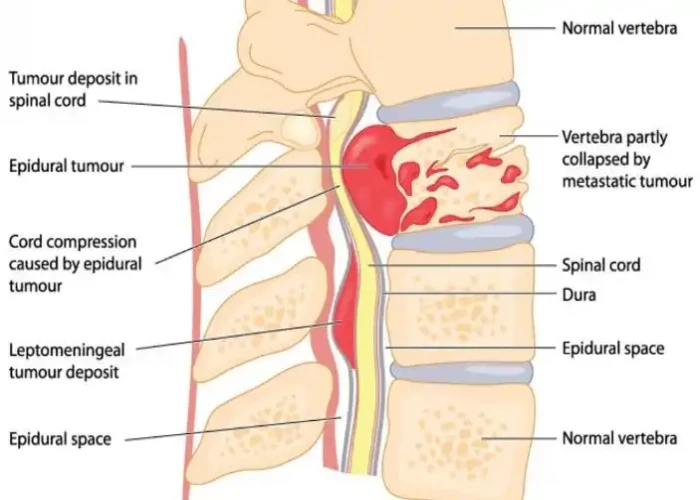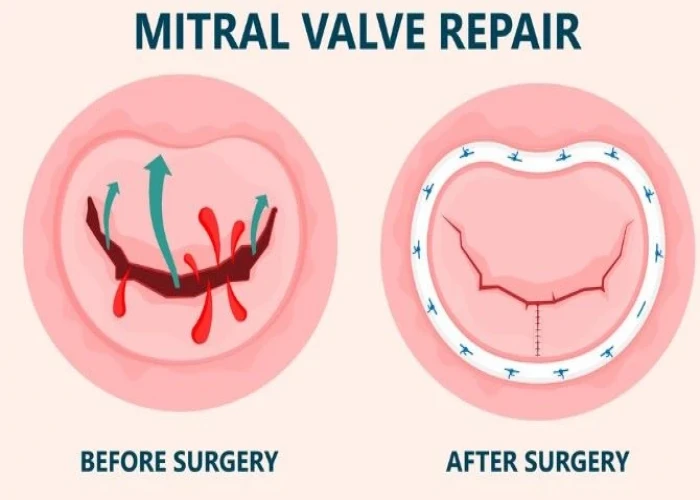 Welcome
Welcome
“May all be happy, may all be healed, may all be at peace and may no one ever suffer."
Vertebral tumor

A vertebral tumor is a type of tumor that occurs in the bones of the spine (vertebrae). These tumors can be either benign (noncancerous) or malignant (cancerous), and they can originate within the vertebral bone or spread from other areas of the body. Vertebral tumors can cause a variety of symptoms, depending on their location and size, including pain, weakness, numbness, and tingling sensations.
Some of the most common types of vertebral tumors include:
- Osteosarcoma: A malignant tumor that develops in bone tissue.
- Chondrosarcoma: A type of cancer that forms in the cartilage of the spine.
- Multiple myeloma: A type of blood cancer that affects the plasma cells in bone marrow, and can lead to bone tumors in the spine.
- Spinal cord tumors: These tumors can develop in the spinal cord or the surrounding nerves and tissues.
The diagnosis of a vertebral tumor typically involves imaging tests such as X-rays, CT scans, or MRI scans. A biopsy may be needed to determine the type of tumor.
Treatment for vertebral tumors may involve surgery to remove the tumor, radiation therapy to kill cancer cells, and/or chemotherapy to destroy cancer cells throughout the body. In some cases, a combination of treatments may be needed. Pain management and physical therapy may also be recommended to help manage symptoms and improve quality of life.
The prognosis for vertebral tumors depends on the type and stage of the tumor, as well as the individual's overall health and response to treatment. Early diagnosis and treatment can improve the chances of a favorable outcome.
Research Papers
Disease Signs and Symptoms
Disease Causes
Vertebral tumor
Vertebral tumors that begin in the spine are very rare, and it's not clear why they develop. Experts suspect that defective genes play a role. But it's usually not known whether such genetic defects are inherited or simply develop over time. Or, they might be caused by something in the environment, such as exposure to certain chemicals.
Most vertebral tumors are metastatic, which means they have spread from tumors in organs elsewhere in the body. Any type of cancer can travel to the spine, but common tumor spread from the breast, lung and prostate are more likely than others to spread to the spine. Cancers of the bone, such as multiple myeloma, also may spread to the spine.
Vertebral tumors are also more common in people who have a prior history of cancer.
Disease Prevents
Disease Treatments
Ideally, the goal of vertebral tumor treatment is to completely get rid of the tumor. But, this might be complicated by the risk of permanent damage to the spinal cord or surrounding nerves. Doctors also must consider your age, overall health, the type of tumor, and whether it is primary or has spread or metastasized to your spine from elsewhere in your body.
Treatment options for most vertebral tumors include:
- Monitoring. Some tumors may be discovered before they cause symptoms — often when you're being evaluated for another condition. If small tumors are noncancerous and aren't growing or pressing on surrounding tissues, watching them carefully may be all that's needed.
- This is especially true in older adults for whom surgery or radiation therapy may pose special risks. During observation, your doctor will likely recommend periodic CT or MRI scans at an appropriate interval to monitor the tumor.
- Surgery. This is often the treatment of choice for tumors that can be removed with an acceptable risk of spinal cord or nerve injury.
- Newer techniques and instruments allow neurosurgeons to reach tumors that were once considered inaccessible. Sometimes, surgeons may use a high-powered microscope in microsurgery to make it easier to distinguish a tumor from healthy tissue.
- Doctors can also monitor the function of the spinal cord and other important nerves during surgery, thus minimizing the chance of their being injured. In some instances, an ultrasound might be used during surgery to break up tumors and remove the fragments.
- But even with advances in surgical techniques and technology, not all tumors can be totally removed. Sometimes, surgery might be followed by radiation therapy, chemotherapy or both.
- Recovery from spinal surgery may take weeks or longer, depending on the procedure or complications, such as bleeding and damage to nerve tissue.
- Radiation therapy. This may be used following an operation to eliminate the remnants of tumors that can't be completely removed, treat inoperable tumors or treat those tumors where surgery is too risky.
- It may also be the first line therapy for some vertebral tumors. Radiation therapy may also be used to relieve pain when surgery is too risky.
- Medications may help ease some of the side effects of radiation, such as nausea and vomiting.
- Sometimes, your radiation therapy regimen may be adjusted to help prevent damage to surrounding tissue from the radiation and improve the treatment's effectiveness. Modifications may range from simply changing the dosage of radiation to using sophisticated techniques such as 3-D conformal radiation therapy.
- A specialized type of radiation therapy called proton beam therapy also may be used to treat some vertebral tumors such as chordomas, chondrosarcomas and some childhood cancers when spinal radiation is required. Proton beam therapy can better target radioactive protons at the tumor site without damaging the surrounding tissue as in traditional radiation therapy.
- Stereotactic radiosurgery (SRS). This treatment, which isn't actually surgery, delivers a high dose of precisely targeted radiation. In SRS, doctors use computers to focus radiation beams on tumors with pinpoint accuracy and from multiple angles.
- There are different types of technology used in radiosurgery to stereotactically deliver radiation to treat vertebral tumors.
- SRS has certain limits on the size and specific type of the tumors that can be treated. But when appropriate, it's been proved quite effective. Growing research supports its use for the treatment of spinal tumors.
- However, there are risks — such as an increased risk of vertebral fractures. Further study is needed to determine the best technique, radiation dose and schedule for SRS in the treatment of vertebral tumors.
- Chemotherapy. A standard treatment for many types of cancer, chemotherapy uses medications to destroy cancer cells or stop them from growing. Your doctor can determine whether chemotherapy might be beneficial for you, either alone or in combination with other therapies.
- Side effects may include fatigue, nausea, vomiting, increased risk of infection and hair loss.
- Other drugs. Because surgery and radiation therapy as well as tumors themselves can cause inflammation inside the spinal cord, doctors sometimes prescribe corticosteroids to reduce the swelling, either following surgery or during radiation treatments.
- Although corticosteroids reduce inflammation, they are usually used only for short periods to avoid serious side effects such as muscle weakness, osteoporosis, high blood pressure, diabetes and an increased susceptibility to infection.
Disease Diagnoses
Disease Allopathic Generics
Disease Ayurvedic Generics
Disease Homeopathic Generics
Disease yoga
Vertebral tumor and Learn More about Diseases

Congenital adrenal hyperplasia

Sclerosing mesenteritis

Acute liver failure

Renal artery stenosis

Mitral valve prolapse

Peripheral nerve injuries

Chronic hives

Hypoplastic left heart syndrome
vertebral tumor, ভার্টিব্রাল টিউমার
To be happy, beautiful, healthy, wealthy, hale and long-lived stay with DM3S.
